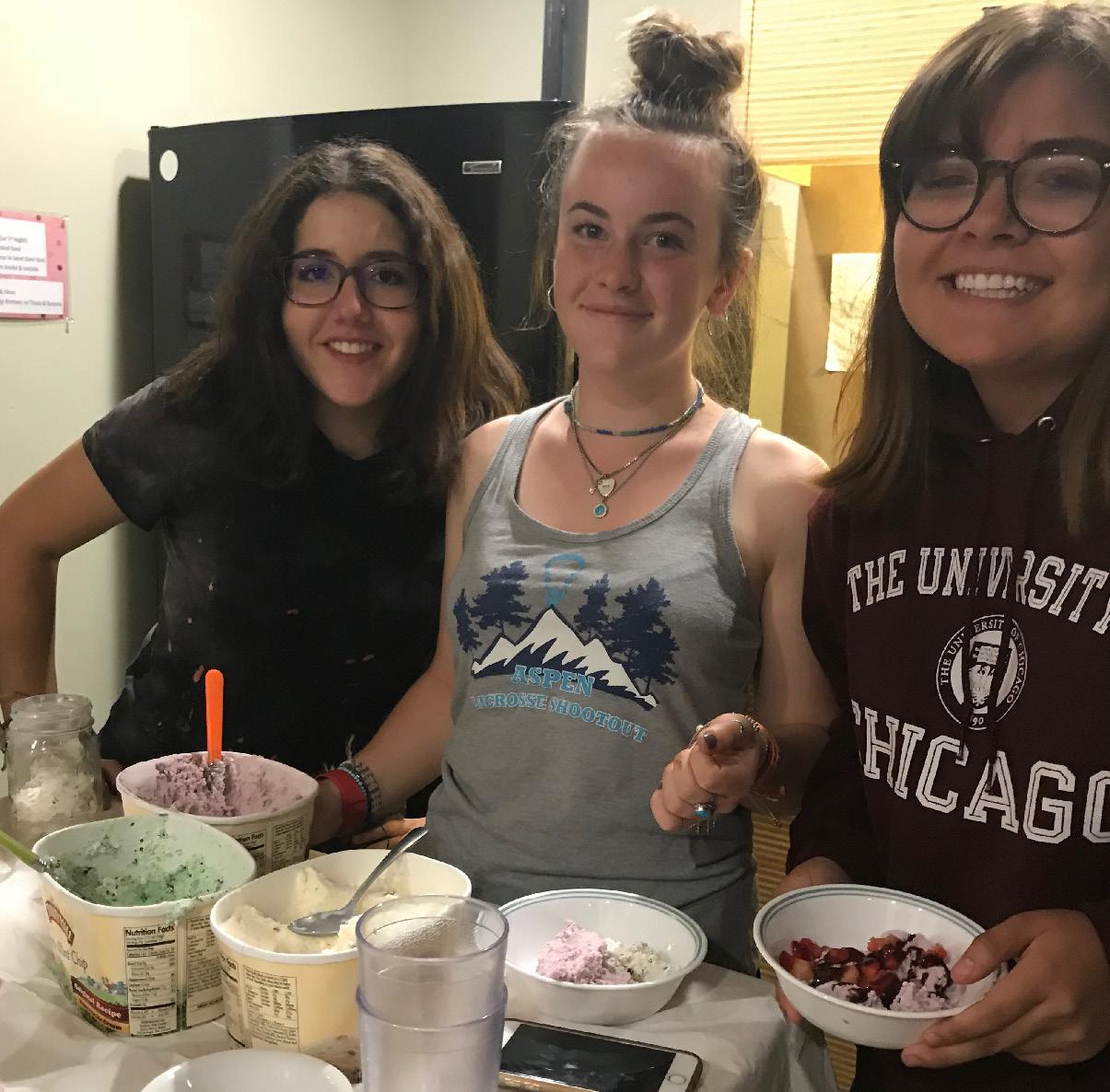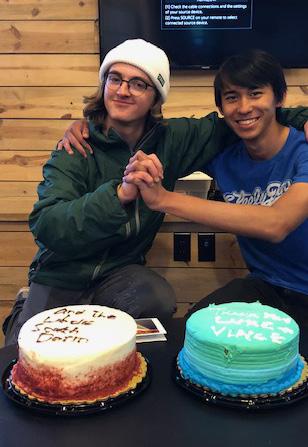
7 minute read
THE RESIDENTIAL GOOD LIFE
- BY ALLISON JOHNSON
In college, students are generally expected to live on their own in a residential community. They’re expected to manage their distractions, get to class on time, study well, ask for help if they need it, and get along with roommates. Such skills don’t always come naturally, and at Colorado Rocky Mountain School, a large part of the residential program includes preparing students to thrive after high school.
“Research says that the high school years are indelible and hugely marked on us because of the way the brain is developing,” says Jennifer Ogilby, Dean of Students. “It’s a tremendously impactful time in our lives. At CRMS, our students are living in a community, forming bonds with each other and teachers. They’re gigantically ready for it, and the experience is deep and raw.”
Living The Residential Life
CRMS has seven dorms, with nearly 60 percent of students boarding at the school. Students are housed by grade and gender in residences that range in size from eight to 20 students. Each dorm has a student “dorm head,” who is responsible for creating the culture and tone for the dorm. A dorm head’s highest purpose is to serve as a liaison between students and staff.
“It’s important for students to have someone in the dorm that they’re more comfortable with and are on the same level with,” says junior dorm head Vince Kunawicz. “It’s important that someone has that responsibility to say hey, if you have problems or ideas for activities, come talk to me, and I can talk to a dorm parent, and we can work things out.”
While every dorm has attached or nearby faculty lodging, each dorm also has a rotating set of four to five “dorm parents” who are staff members or teachers that oversee a dorm on a rotating basis. Although dorm parents take their role as seriously as a parent would, the word “parent” is a bit of a misnomer.
“This age is a time when teens are seeking out adult mentors who aren’t their parents,” says Director of Residential Life BJ Sbarra. “We fill an important role. We’re here to provide guidance and help them figure out what it is that they care about, what’s important, what they are going to stand for, what their values are.”
Ogilby calls the dorm-parent style “objective parenting,” and Sbarra agrees.
“Parents often ask, how do you get them to clean their room?” says Sbarra. “We’re not their parent. We have a different relationship with them, but the number one component of the program is that we want our kids to feel cared for and supported and give them what they need to succeed while they’re here.”
Most students also have a roommate. Sbarra, Ogilby, and the admissions office staff meet for hours annually to pair up new roommates based on student questionnaires and knowledge about the students. Returning students can request roommates, and the committee tries to honor those requests when possible. Roommates serve an important role in the residential program.
“The bond between two roommates is really strong,” says Christi Ashenden, junior dorm head for the Crystal dorm. “Your roommate knows you better than anyone else. They always know where you are in your life. That relationship is really important. And for boys too. They love the roommate bond they have.”
Sbarra admits that for some students living with a roommate for the first time can be hard. To that end, at the beginning of the year, all assigned roommates sit down and draw up a roommate contract, including elements like what’s okay to share, pet peeves, and how they’ll manage conflict. The contract provides the groundwork to refer back to as the year progresses. It’s part of an intentional piece in the residential program to teach life skills that will serve students well long after they’ve left CRMS.
“In our program, they’re learning to live on their own, resolve conflict, manage little things like how much time they need in the morning to get up for breakfast,” says Ogilby. “These are things that everybody faces at some point. They’re age-appropriate challenges.”
Living The Healthy Life
The CRMS residential program is structured around helping students develop healthy habits, and both dorm heads and dorm parents play an important role toward that goal.
“I like to say that in the dorms is where life happens,” says Sbarra. “We’re a college-prep school so they’re gaining a lot of skills and building a degree of autonomy that they wouldn’t necessarily have if they were living at home.”
Good habits and work skills are reinforced nightly. All students are expected to be in their dorms by 7:30 p.m. on weeknights. The evening starts with dorm jobs.
“Everyone is exposed to different kinds of work to make sure the dorm is clean,” explains Kunawicz. “Someone’s going to have to clean the bathrooms, clean the common room, wipe down the tables, sweep the hallway, mop the floor.”
While the evening also includes a study period where students are building important academic and time-management skills, the dedicated time also includes a social component with a nightly dorm meeting.
“This is the time where everybody in the dorm comes together,” says Ashenden. “It feels really important because the faculty genuinely want to know how we’re feeling and how we’re doing. Their role is a lot deeper than just showing up at 7:30 p.m. They’re there to support us, and we all trust them and share a lot of ourselves with them. They really do feel like parents.”
Dorm meetings are times for students and dorm parents to connect, discuss important life issues, and build relationships.

Sometimes dorm parents will lead discussions on school values such as gratitude or curiosity. Other times they’ll share important parts of their lives.
“CRMS students are used to reflecting and self-assessing,” says Ogilby. “They’re really well practiced and skilled at sitting in a group, listening to one another, not having phones out, and being respectful of group meeting time. It’s pretty remarkable in today’s adolescent world.”
During the weeknights, lightsout happens at 10:30 p.m. This combination of structure, dorm responsibilities, and relationships anecdotally pays off. Ogilby has heard reports that compared to other college freshmen, CRMS students are steady and balanced when they get to college. They know what they need to do and have independence. Sbarra has also seen the fruits of the program pay off.
“Sometimes you have to take the longer view,” he says. “Students don’t always get it while they’re here, but a lot of students come back a few years later and thank us. The boarding program helps students become individuals who can live in a community and respect each other. A lot of students don’t get that experience until they go to college. It gives our students a leg up.”
Not all structure and rules are popular. Freshman and sophomore students have their phones taken away on weeknights to help build healthy technology habits, while rules regarding visitation in the dorms are generally considered too strict. It’s an opportunity for constructive dialogue between students and staff.
“We give them a lot of trust and responsibility,” says Sbarra, “but we do have rules and expectations too. Teenagers are naturally pushing up against boundaries and asking the whys. We help them understand the whys and create a solid foundation for them to build on.”
Living The Fun Life
Residential life isn’t all rules and skill building. It’s also a time of fun. On Wednesdays, the work stops at 9 p.m. for Captain Miercoles, a school-wide tradition where everyone stops to blow off steam and participate in an all-school game or activity. Miercoles is so popular that even day students return to campus to participate.
Dorms regularly plan their own activities as well. On the weeknights, activities might include going to 7-11 for slurpies or celebrating birthdays. On the weekends dorms have more flexibility to plan events and co-mingle between the dorms in the boys’ dorm that might look like a video game competition. In the girls’ dorm, there might be a dance party. On a recent night this spring, a girls’ dorm visited a boys’ dorm to give the boys a makeover. Bonfires, bakeoffs, barbecues, dorm Olympics, ski trips, and movie nights all keep the students engaged and having fun on the weekends.
“They’re always creative and trying different things,” says Sbarra. “I walk into a dorm sometimes, and I’m like OK, what is this random thing you guys have done? For a lot of us dorm parents, the dynamic nature of teenagers really keeps it fun.”
Living The Community Life
Ask a CRMS boarding student for a word that defines the Residential Life Program, and they’re likely to use the word “family”.
“People in the dorms become your family because you’re always with them and you have to rely on them. That’s really special about the Residential Life Program,” says Kunawicz.
That word isn’t confined to peers, either. Ashenden notes that the relationship students build with their dorm parents is vital. “You’re never alone. Anytime you need help, there are 16 other girls along with the dorm parents who want to help you. Everyone knows what’s going on in each other’s lives, which is really powerful. It’s like having a larger family.”
Sbarra attributes that strong bond between adults and students to the size of the school. “Because we’re a small school, what makes us stand out is just the individual care, attention, and support that we can give our students. We work incredibly hard to help students succeed. That’s one of the big things we pride ourselves on, for every student to be successful in their high school experience and be ready to go on to what’s next.”
Like most relationships, family can have its ups and downs, and learning to use their voice and work through conflict is an important goal of the residential program.

“There’s a lot of personal change and learning that can come from living together like that,” says Kunawicz. “It’s a very special kind of learning environment when you’re living with people who come from other parts of the country and world. Sometimes you learn what annoys you and bothers you, but you can also find out what kind of people support you and how to find those kinds of people.”
In the end, Sbarra sees the residential program not as a separate entity in the school but as an extension of the work and values going on at the school every day.
“Relationships are everything at this school,” he says. “In the dorms, we continue to build on all the things going on in other parts of the school to help students develop to be selfsufficient, critically-thinking young adults.”








